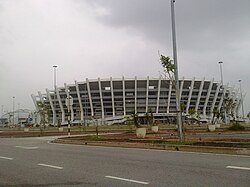Sultan Mizan Zainal Abidin Stadium
 | |
 | |
| Location | Gong Badak, Kuala Nerus District |
|---|---|
| Coordinates | 5°22′22″N 103°6′23″E / 5.37278°N 103.10639°E |
| Owner | Terengganu State Government |
| Capacity | 50,000 |
| Construction | |
| Built | 2006 |
| Opened | 2008 |
| Construction cost | RM 270 million |
| Architect | Raja Datuk Kamarul Bahrin Shah |
| Tenants | |
| Terengganu (Malaysia Super League) | |
Sultan Mizan Zainal Abidin Stadium is a multi-purpose stadium in Kuala Nerus District, Terengganu, Malaysia, constructed by a South Korean construction firm.[1] Together with the adjacent Mini Stadium, it forms the centrepiece of Terengganu Sports Complex. It was used mostly for football matches. The stadium holds 50,000 people and is named after the reigning Terengganu Ruler, Sultan Mizan Zainal Abidin. The biggest stadium in the East Coast region of Peninsular Malaysia, it was built to replace Sultan Ismail Nasiruddin Shah Stadium as the state's main stadium. Sultan Mizan Zainal Abidin himself, who was then the 13th Yang DiPertuan Agong officiated the stadium on 10 May 2008. Its first major use was as the main venue for Sukma Games 2008.[2]
Collapse of the roof
On 2 June 2009, a major part of the roof construction collapsed under normal weather conditions, including the section above the royal box.[3] It was only about a year after the stadium was officially opened. Witness accounts indicated that a long loud sound similar to a jet engine noise was heard as the roof fell to earth in pieces. A number of staff were in the stadium during the collapse, with preparations for varsity staff games being made. In addition to the games getting cancelled, many pieces of equipment were either damaged or destroyed and vehicles parked nearby being damaged. Fortunately, no casualties were reported.
The major cause for the collapse of the roof was identified to be the design fault and inappropriate materials.[4] There were also reports of sporadic loud bangs and structure damage prior to the collapse. One of the structural repair jobs on the roof was scheduled on the day of the collapse itself, along with some electrical repair works being carried out on other part of the stadium. As of June 2010, the cleaning work and relocation of the collapsed roof were not finished.[5]
On 19 December 2011 Terengganu Menteri Besar Ahmad Said confirmed that the stadium would be repaired by early 2012 with alterations to its roof design, mulling it to be similar with that of the Bukit Jalil National Stadium.[6]
On 20 February 2013 the stadium collapsed again while undergoing re-construction work which commenced late 2012. 137 meters (two-thirds of the old structure) collapsed when working construction workers heard loud noises, followed by the collapse of steel pillars. The collapse cause injuries to 5 workers with 3 of them suffering serious injuries.[7]
Events
Politics
The stadium's fate was overseen by Malaysian Opposition as a part of the administration by the former Barisan Nasional government led by then Menteri Besar Idris Jusoh. Idris was removed from Wisma Darul Iman following a fallout with the Terengganu Palace shortly after the 2008 General Elections, an event that formed the background of the 2008 Terengganu Constitutional Crisis.[8] One of his replacement, Ahmad Said's early duties was to attend the officiating of the stadium, a project closely overseen by him.
See also
References
- ^ MACC men begin probe, the star online, 3 June 2009
- ^ "Terengganu opens East Coast's largest stadium". TheStar Online. 11 May 2008. Retrieved 11 May 2008.
- ^ The Real Reason Why Sultan Mizan Zainal Abidin Stadium in Malaysia Collapses, zimbio.com 4 June 2009
- ^ Collapse of Sultan Mizan Zainal Abidin Stadium due to design and materials used, MALAYSIATODAY.com 8 January 2010
- ^ Cleaning Work On Sultan Mizan Stadium To Start Next Week, BERNAMA.COM, 30 June 2010
- ^ Terengganu to replace grandstand roof with new design, The Star Online, 19 December 2011
- ^ Bernama News, 21 February 2013
- ^ Palace-Government Crisis
